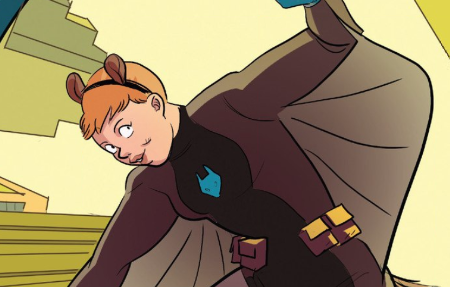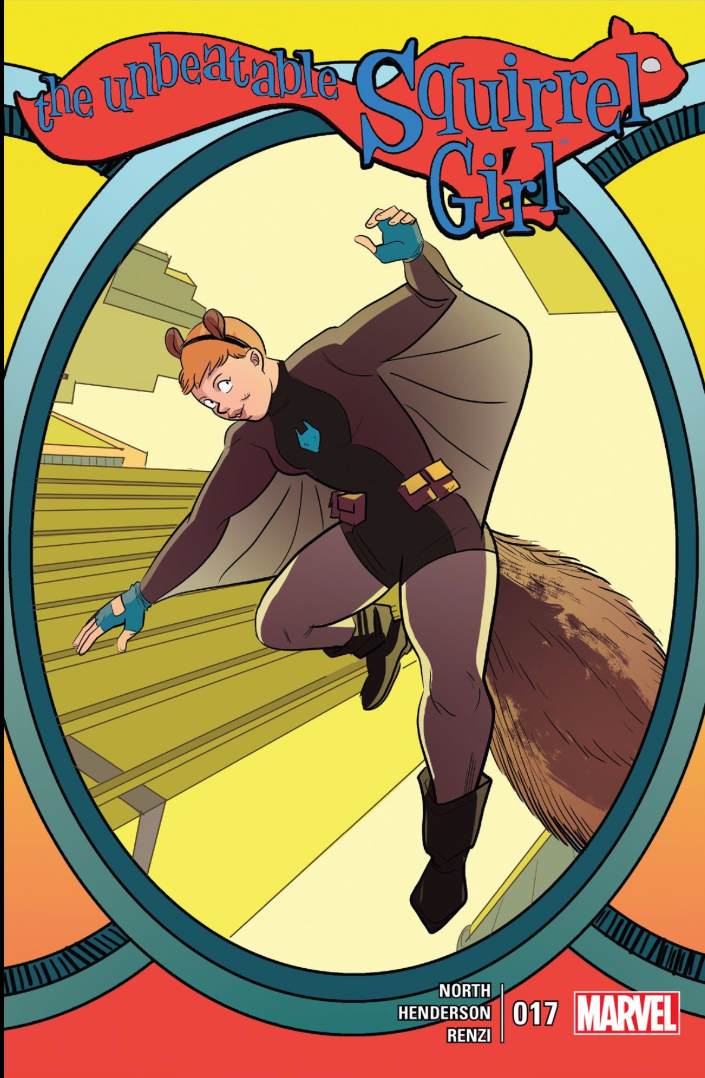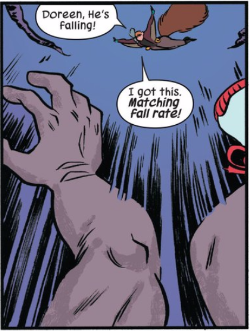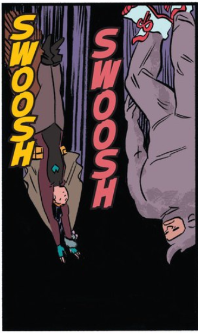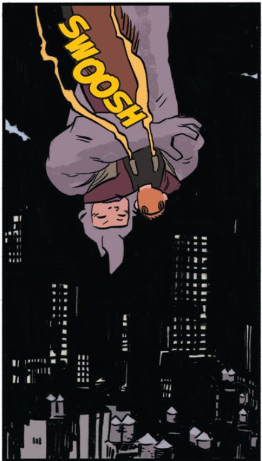We’ve all wondered from time to time. If Squirrel Girl and the Rhino fall for about a minute – do they have time for a quick yet meaningful conversation?
Admit it – you’ve thought about it.
Before we start, let’s get one thing clear – I love Squirrel Girl. As a STEM teacher, finding comics that take the time to dig into science, technology, engineering and math and make sure they’re getting things right (or as close as they can to right that the story allows) is awesome, and finding comics that do that, while featuring a female protagonist and are fun to read – they’re needles in haystacks (*). Got it? I love Squirrel Girl.
Which is to say this may be biased.
So let’s set this up. In The Unbeatable Squirrel Girl #17 (still on the shelves at your local comic shop, or available online from Comixology, here), Doreen Green (Squirrel Girl) gets a mysterious benefactor who gifts her with a jetpack and wings, turning her from a ground-based Squirrel Girl into a flying Squirrel Girl. On her first night out with her jets and wings, SG runs into the Rhino and flies straight up with him. The Rhino’s not impressed (this tactic has been used on him before), and keeps punching Doreen as they get higher and higher, leading to her finally pushing him away.
Seeing him falling, Doreen realizes that in order to help him, she needs to match his fall rate (Yay! Good science mention!). Once she does, the two have a conversation for about a minute (seriously – it is about a minute. That’s what series writer Ryan North claims in a footnote, and what I found too, when I read the dialogue out loud). As Squirrel Girl and the Rhino are reaching the tops of the buildings, they grab on to each other, and she lands them both safely.
It’s a neat scene that demonstrates SG’s science knowledge and that the writer was actually up for doing some of the work – North clams that the fall, with standard air resistance, taking about a minute was “100% scientifically accurate.”
So – what can I, as a STEM teacher do with this?
As a quick disclaimer, my classes are infused with pop culture from the start, so introducing someone named Squirrel Girl or comics to my students wouldn’t be anything out of the ordinary. That said – what would I do with this?
Simple – I’d have my physics students check North’s work and come back with the minimum height at which SG and the Rhino started falling. The question would end up with asking my students if this scene, with its fantastical elements as a given, was plausible. And I wouldn’t play – I’d make sure I explained the question clearly so there would be no confusion about what I was asking, and this would be a question for credit. Not bonus or extra credit, a straight-up grade.
Let’s figure out what I’d be looking for…
(Pssst – hey, you – yeah, you, who’s not a STEM instructor or a student…this is cool stuff here, stick around and work with us, and by the time we’re done, you’ll get the idea of how things fall and what goes in to slowing things down and stopping them. Physics is fun!)
Conceptualizing and Outlining the Problem
First, students need to get an overview of the problem and figure out how many steps it will take to get an answer (physics problems are notoriously multi-stepped). This will require prior knowledge on a couple of fronts.
As always, problems like this start with two questions:
- What am I being asked for?
- What was I given?
Once those questions are answered, it’s time to ask if you can get to the answer directly, or if you need intermediate steps.
For this problem, I would ask for the minimum height from which Squirrel Girl and the Rhino can fall. I would give them virtually nothing. That’s not me being mean – they really don’t need that much, and moreover, I want them to be independent problem solvers. The things that they need, they can look up for themselves.
The outline of the problem is crucial. It’s the plan of attack or “battleplan” as we call it in my classes. Without one, students tend to flail a lot as they wander down dead ends and have to come back and start again. After a few dead ends, the students unfortunately end up with a jumble of concepts and numbers in their heads that push the correct approach and ideas farther away than when they started.
So for this problem – what would an outline look like?
Start with prior knowledge – what do we know about things that fall?
- Everything near the earth’s surface falls at the same rate – 9.8 m/s2, that’s the acceleration due to gravity. The negative sign means it’s falling down, not up (which would be positive).
- When things fall through the air, they encounter resistance (the air pushing back on the object). While exact calculations of drag are not within the scope of many high school physics classes, students who’ve studied free fall should know about terminal velocity. Terminal velocity is the speed you reach when you’re falling and you just can’t fall any faster. The force pulling you down is equal to the resistance from the air pushing against you as you fall. For human-like objects in the head-down position, that terminal velocity is between 240 – 290 km/hr, which, if we convert to standard units and average, is roughly 74 m/s, downward.
- Also, when things are dropped, their initial velocity, that is their velocity right before they start falling, is 0 meters/second.
- The time of the conversation portion of the fall is about one minute – I’m going to use 80 seconds, just to build in a fudge factor in case I was talking too quickly when I read the conversation out loud and timed it.
So we’ve got a little to start with. What else? I’d expect them to look up and find:
- From Marvel.com (a reliable source), the Rhino’s weight is 710 pounds, which converts to 322 kg of mass.
- For Squirrel Girl, a fine weight estimate would range anywhere between 100 and 160 or so pounds, which converts to about 45 – 73 kg. I wouldn’t be fussy about the weight/mass of Doreen, unless the student gave a value that was just unreasonable (waay too low or waay to high, or forgetting to convert pounds to kilograms). She’s a late-teen/very early ‘20s normal sized, athletic girl, and shown not to have a typical “super-hero” body type.
- A stopping speed for touchdown. We’ll need one. Students sometimes, when working these problems, just have them…end. If you’re falling and the calculations just “end,” then you’ve just slammed into the ground. You’d like the falling people to slow to a speed that will ensure survival on touchdown. For this, I looked up the average touchdown speed of a parachutist, about 28 km/hr, which converts to -7.8 m/s. That’s a good estimate that I can work with.
As for the battleplan, by this point, I’d hope my students can see the part of the problem clearly:
- Calculate how long it takes Squirrel Girl and the Rhino to reach terminal velocity.
- Calculate how far SG and the Rhino fall during that time.
- Calculate how much farther they fall during the remainder of their conversation (80 seconds minus the time it takes in #1 to reach terminal velocity).
- Calculate how much time they’ll need to slow to an appropriate speed for touchdown.
- Finally, calculate how much farther they’ll fall during that slowdown to their touchdown.
Take all of those calculated distances (#2, #3 and #5) and add them together, and that’s our minimum height for a safe fall, meaningful conversation and landing.
Let’s get to work.
Step 1: A Squirrel Girl and Rhino Get Terminal
Before we get into this, let me just say that if my students forget to bring terminal velocity into this problem, they’d get a totally bonkers series of answers – something like a max downward velocity of nearly 600 meters/second (just under twice the speed of sound) and a minimum height of over 36,000 meters. Hopefully, somewhere along the line, bells would be going off to suggest to them that this was way, waaay wrong.
To calculate the time needed to get to terminal velocity for both Squirrel Girl and the Rhino, we treat it like every other problem – what do know (or are given) and what do we need to find out?
- Initial velocity (vi) = 0 m/s (we’re using that for the Rhino, since he starts the fall and SG catches up to him…it all works out just fine)
- Final velocity (vf) = – 74 m/s (terminal velocity, the negative sign indicates the direction of the velocity is downward)
- Acceleration (a) = – 9.8 m/s2 (again, negative sign indicates that the direction)
- Time (t) = ? (that’s what we’re solving for)
To solve the problem, we need our trust kinematics equations. Kinematics equations allow us to predict information about the motion of objects if other pieces are known. Depending on who you ask, there are around four of them that physics students will constantly use, and for this instance, we need:
vf = vi + at
Plug our numbers in, and we get:
-74 = 0 + (-9.8)t
Solve for t:
t = 7.5 seconds
So – it takes 7.5 seconds for Rhino to reach -74 m/s after starting at 0 m/s.
Well, that’s cool to now, but it’s only a step in what we’re looking for. We’re after the total vertical distance our two hapless fallers need to fall and stop safely. That leads us to step 2 of our problem:
Step 2: How far does Everyone Fall in 7.5 Seconds?
An important side note that I’d expect my students to understand by this point in the course is that everything we’re doing with time and distance in steps #1 – #3 is independent of mass. In other words, it doesn’t matter if we’re talking about Squirrel Girl and the Rhino, or you and a buddy. Everything would do the same thing here. Every person oriented in the same way would take about 7.5 seconds to reach 74 m/s, downward. As always, thanks gravity, for being so darn consistent. Everything falls at the same rate. The only thing that mucks it up is air resistance. Take away the air, and a bowling ball and feather will fall at the same rate.
Video proof:
Back to Squirrel Girl and Rhino (or anyone). How far will they fall in 7.5 seconds?
We need another kinematic formula. A common mistake my students would make here is that they would use the formula showing that displacement = speed multiplied by time. They get tricked into this by the terminal velocity – that’s a constant velocity once you reach it, true, but we’re talking about getting to terminal velocity here. This part of the fall has accelerated motion. We need a formula that reflects that. Our champion is:
Δy = ½at2 + vit
Δy is our vertical displacement or distance moved downward in the time they’re falling. We know all the other numbers, so…
Δy = ½(-9.8)(7.5)2 + (0)(7.5)
Δy = -276 meters
(again, negative means they’re going down)
Okay – now we’re getting somewhere. That’s a piece of our total distance. It’s only a piece, though. We need to keep working to get the rest.
Step 3: Talking and Falling, Falling and Talking
As I mentioned earlier, Rhino and Squirrel Girl are falling for 80 seconds, total. It took them 7.5 seconds to get up to terminal velocity, so they’ve got 72.5 seconds (80 seconds – 7.5 seconds) left to fall at -74 m/s.
Okay – this calculation is easy. The downward velocity is constant, so it’s the same calculation you’d use to figure out distance when you’re traveling at a constant speed:
Distance (downward displacement, in our specific case) = velocity multiplied by time, or:
Δy = vt
With numbers:
Δy = (-74)(72.5)
Δy = -5365 meters
Great – another piece of our total vertical distance that we’ll add to the value we got in step #2.
We’re not done yet…if we end here, they’re going to smack into the ground, which is not the ending either of them had in mind.
Step #4: Coming in for a Landing
Now we need mass.
Any object in motion has momentum (mass times its velocity), and to change its momentum, you need a force delivered over time. That’s called an impulse. How does this apply to our intrepid fallers? They don’t want to die. Slowing down too fast (or over a short period of time) isn’t good for your insides. When you’re coming in for a landing, you want a gentle, controlled slowing and soft touchdown. Bones don’t get broken and internal organs stay where they’re supposed to be that way.
What formula do we need? Impulse will do it for us. The formula says:
Force multiplied by time equals the change in momentum experienced by an object, or
Ft = mΔv
Where F = force, t = time, m = mass, and Δv = the change in velocity experienced by the object.
Buckle up, because this gets a little tricky.
What we need to get from this is a force, and from that, we can get an acceleration felt by our fallers. So, we need to solve that impulse equation for force, which means we divide both sides by time, or:
F = mΔv/t
Solving for mΔv, we bring in our masses of the Rhino and Squirrel Girl – 322 kg + 45 kg = 367 kg. I added them together because by this point in the fall, Squirrel Girl had grabbed on to the Rhino, so we can treat them as if they’re one mass.
Δv is just another way of saying “the change in velocity” or vf – vi, or -7.8 – (-74) = -66.2 m/s. The final velocity came from the average “soft landing” for parachutists, earlier. And as always, the negative just means down.
So – doing the math:
Ft = (367)(-66.2)
Ft = -24295 Ns
(the unit is a yucky one – “Newtons times seconds” which is the bastardized unit that we use for momentum)
This is not what we want – we want a force, and then, once we have a force, we can figure out an acceleration via Newton’s Second Law of Motion – F = ma, or the force required to make something move is equal to the object’s mass multiplied by its acceleration. To wring acceleration out of Newton’s Second, we just divide both sides by mass and get a = F/m.
But – before we can get there, we need a Force. So – we need to adjust our formula above and divide both sides by time, or:
F = -24295/t
What time should we use? Time to estimate. Let’s make a table. Tables are fun.
| Time for slowdown | Force – mΔv/t | Acceleration – F/m |
| 5 seconds | 4859 N | 13.2 m/s2 |
| 10 seconds | 2430 N | 6.6 m/s2 |
| 20 seconds | 1215 N | 3.3 m/s2 |
| 30 seconds | 810 N | 2.2 m/s2 |
So what do these numbers mean? We’re looking at acceleration in the right hand column. We want this to be a gentle landing, so we want our landing not to feel like we’re still falling. Both Doreen and the Rhino are probably looking to use their knees again after this landing, so we want to minimize their impact – I’ll take anything from half of gravity (4.9 m/s2) on down as an acceptable answer. I’m going to use that 2.2 m/s2 as my acceleration. By selecting that acceleration, they’ll need 30 seconds to slow down from -74 m/s to -7.8 m/s.
Oh, and by the way – the force (middle column on the table) that’s doing all of this for us? That’s being provided by Squirrel Girl’s brand-new jetpack from her mysterious benefactor, Melissa Morbeck. If you want to figure out the amount of energy to produce the 810 Newtons of force, as well as how tightly Squirrel Girl would have to hold on to the Rhino so he doesn’t slip out while they’re slowing down, that’s awesome! But we’re not going to worry about it here. It’s not impossible to figure out, it would just make all of this about twice as long.
Anyway – that 30 seconds is a cool piece of information, but it’s only a piece that gets us closer to the final step, and the final distance.
Step #5: That Final Piece of the Puzzle
In step #4, we figured out how much time we need to slow down from terminal velocity of -74 m/s to a walk-away-from -7.8 m/s landing – 30 seconds. Using 30 seconds to slow down means that we’ll be accelerating (okay, decelerating, but physics kinda hates calling it that, we prefer negative acceleration – same idea, different words) at 2.2 m/s2. Nope – it’s not negative this time. If I’m heading down, then my velocity will be negative: -74 m/s, remember? If I want to slow down, my acceleration has to be in the other direction, in this case, up. So the sign of the acceleration that will slow down Squirrel Girl and the Rhino is positive. If it was negative, we’re just be adding to their downward velocity, which would be…bad. Horribly, comic-book-series-ending bad. The negative acceleration bleeds off downward velocity over 30 seconds
What do we need to figure out here? That last bit of distance. For that, we need our old friend:
Δy = 1/2at2 + vit
We’ve got some new numbers this time:
a = 2.2 m/s2, t = 30 seconds, and vi = -74 m/s, so…
Δy = ½(2.2)(30)2 + (-74)(30)
Δy = 990 – 2220
Δy = -1230 meters
Altogether now, “negative means down.”
You didn’t miss it did you? We’re done.
From Steps #2, #3 and #5, we’ve got the three distances we can add together to get our total distance:
Δy = -276 + (-5365) + (-1230)
Δy = -6871 meters
So – using our numbers (all pretty good estimates if not exact numbers), the idea of Squirrel Girl and the Rhino falling for a minute and talking – completely plausible.
To really put nails in the coffin of this problem. North pointed out in a footnote to the scene, there’s enough breathable oxygen in the atmosphere up to about 26,000 feet, so loss of consciousness wouldn’t be an issue if you stay under that threshold. 6871 meters is about 22,543 feet, so our fallers were comfortably under that barrier when they began their fall. North said in his footnote that the scene is 100% scientifically accurate, and we can’t find any room to quibble with him about it.
Back to teacher mode – this clearly would be a summative assessment for my students. A capstone exercise to make sure that they completely understand the concepts of kinematics, freefall, momentum and impulse. Easily a quiz grade if not part of a larger test…or maybe a project where they would have to write up an answer in this style of format to explain what they did and why they did it. That’s a problem I run into a lot with physics students – they can get good with the mechanics of it all, but stumble when they have to explain why they did what they did.
Of course, the whole exercise can be scaffolded as much or as little as you need. For my IB Physics students (or AP level), I wouldn’t give them anything except a little guidance that they may have to look some values up. For my Honors Physics – I’d help them out a bit more, and maybe make sure they can clearly see all five steps of the problem.
But all in all, I love using problems like this in my class. It makes kinematics sticky – it adds a story to the problem, and students have a deeper connection to it than they did before. Give it a try in your own class.
Next time, we’ll look at a problem that I did assign to my class which required them to use roughly – the same tools, but asking if a fall while holding on to someone from a great height be survivable. Spoiler warning: this one wasn’t so plausible.
(*) – okay, you caught me – they used to be needles in haystacks, but thanks to comics like Ms. Marvel, The Unstoppable Wasp and The Unbeatable Squirrel Girl, they’re more common than they’ve ever been.
Want to learn more about free fall and kinematics? Check out The Physics Classroom – explanations, sample problems, interactives…you’ll feel like you’re in physics class, without all the peer pressure and wondering when the bell is going to ring for lunch.
Final footnote – as Twitter user @pquade pointed out, while the physics might be spot-on, actual conversation, given the wind ripping by your mouth and ears as you fell would pretty much be impossible. Dang.


